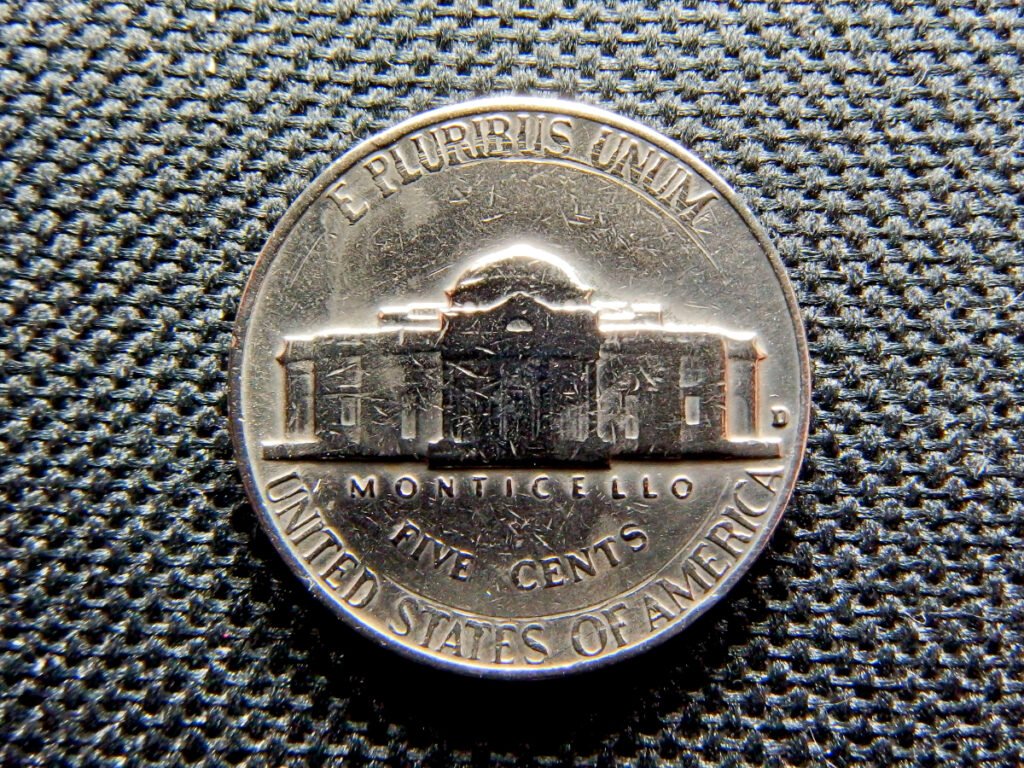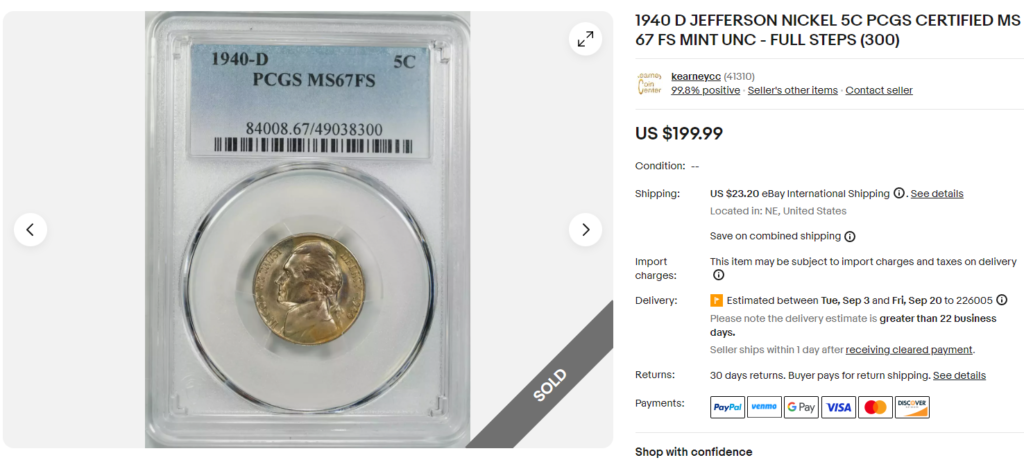Imagine holding an ordinary old 5-cent coin from 1940, only to discover that it is, in fact, a hidden treasure trove of value. While most 1940 Jefferson nickels fetch between $0.10 and $1.80 in circulated condition, rare specimens can command thousands of dollars at auction.
Point in case, a fine 1940 Jefferson Nickel graded MS68 with Full Steps was sold for an astonishing $6,400! So, if you want to find out if your 1940 nickel is worth the money, this guide is for you!
It explains how specific features, such as mint marks, minting errors, exceptional grades, and historical nuances, can transform a common coin into a BIG FORTUNE!
An Overview of 1940 Jefferson Nickel History
The Jefferson Nickel was first introduced in 1938, replacing the Buffalo Nickel design in circulation since 1913. Felix Schlag, who won a design competition held by the U.S. Mint, created the new design featuring Thomas Jefferson on the obverse and his home, Monticello, on the reverse.
By 1940, the Jefferson Nickel had been in circulation for two years and was well-established in American coinage. This year marked a significant period in U.S. history, as the nation was emerging from the Great Depression, and tensions were rising in Europe with the onset of World War II.
In 1942, the Mint began producing “War Nickels” with a silver alloy to conserve nickel for the war effort. The 1940 Jefferson Nickel holds particular interest for collectors as it represents one of the series’ early years, produced before the composition change during World War II.
| 1940 Jefferson Nickel | Key Features |
| Material (Composition) | 75% Copper, 25% Nickel |
| Minting Location | Philadelphia, Denver, San Francisco |
| Minting Year | 1940 |
| Weight | 5 grams |
| Diameter | 21.2 mm |
| Thickness | 1.95 mm |
| Designer – Engraver | Felix Schlag |
| Face Value | $0.05 |
| Mint Marks | No mint mark (Philadelphia), D (Denver mint), S (San Fracisco) |
| Total Mintage | 259,729, 158 |
How to Identify a 1940 Jefferson Nickel (Design & Composition)
Designed by Felix Schlag, the 1940 Jefferson Nickel features distinct design elements that make it easily recognizable.
1940 Jefferson Nickel Obverse Design:
- Left-facing profile of Thomas Jefferson
- The words “IN GOD WE TRUST” to the left of Jefferson’s portrait
- The word “LIBERTY” to the right of the portrait
- The mint date “1940” on the lower right corner, below Jefferson’s neck
- The designer’s initials “FS” are not present (added in 1966)
1940 Jefferson Nickel Reverse Design:
- Depiction of Jefferson’s home, Monticello
- The words “E PLURIBUS UNUM” above Monticello
- “MONTICELLO” inscribed below the building
- “FIVE CENTS” at the bottom of the coin
- “UNITED STATES OF AMERICA” arching around the top edge
- The mint mark, “S” or “D,” if present, to the right of the Monticello
Coin Composition & Dimensions:
The 1940 Jefferson Nickel was composed of 75% copper and 25% nickel, giving it a silver-like appearance. This composition remained consistent from the coin’s introduction in 1938 until the changes to War Nickels in 1942.
The coin measures 21.2 mm in diameter and weighs 5 grams. Its edge is smooth, lacking the reeding found on some other U.S. coins. These specifications have remained unchanged since the coin’s introduction, making the 1940 Jefferson Nickel consistent with other series years regarding physical characteristics.
4 Factors to Find the 1940 Jefferson Nickel Coin Value
Generally, a circulated 1940 Jefferson Nickel is worth its face value of five cents or slightly more. On the other hand, uncirculated nickels of excellent quality or with rare features can be worth hundreds to a few thousand.
Let’s understand the factors that play crucial roles in determining a 1940 Jefferson nickel coin’s value:
1. Mint Marks & Mintage

The total mintage for 1940 Jefferson Nickels across all mints was 252,383,500. This high mintage makes these coins quite common; hence, they are only worth the face value in circulated condition.
The mint mark, representing the minting location, can be found on the reverse of the coin to the right of Monticello.
- 1940 Jefferson Nickel No Mint Mark: The Philadelphia Mint produced around 176,499,158 Jefferson Nickels in 1940. These coins bear no mint mark and are worth only their face value in circulated condition. Uncirculated 1940-P nickel coins can range from $1 to $20, with MS66+ or MS67 examples fetching up to $100 – $150.
- 1940-D Jefferson Nickel: The Denver Mint struck around 43,540,000 1940 Jefferson Nickels, making them less common than Philadelphia-minted coins. You can expect a value of $25 to $40 for common mint grades and $150 – $200 for higher grade examples.

- 1940-S Jefferson Nickel: The least common of the three mints, San Francisco-minted 1940 Jefferson Nickels are slightly more valuable due to their lowest mintage of 39,690,000. Uncirculated 1940-S nickels are worth $2 to $30, with MS65 and higher grade examples fetching $50-$250 or more!
2. Coin Grading and Condition
The condition of a coin significantly impacts its final value. Based on the Sheldon Scale, ranging from Poor (P-1) to Perfect Mint State (MS-70), 1940 Jefferson Nickels graded MS60 or higher (uncirculated) command premium prices. For example, this 1940-S nickel MS67+ sold for $650 on the Great Collections auction.
You can use the following 1940 Jefferson Nickel Value Chart to find the average price of your old coin.
| Coin Grades | 1940 No Mint Mark Nickel Value | 1940-D Nickel Value | 1940-S Nickel Value |
| Poor (0) to Extremely Fine (XF45) | Face Value (a few cents) | Face Value (a few cents) | Face Value (a few cents) |
| Almost Uncirculated (AU50) to Mint State (MS60) | $1 – $10 | $1 – $10 | $1 – $10 |
| Mint State (MS60 – MS66+) | $10 – $50 | $10 – $50 | $10 – $ |
| Mint State (MS67 onwards) | $50 – $150+ | $50 – $200+ | $50 – $350+ |
3. Full Step Designation (FS)
The 1940 Jefferson Nickel is notable for its Full Step (FS) designation, which refers to the quality of the coin’s details of the steps on the Monticello building on the reverse. This designation can greatly influence the coin’s value.
The FS designation is awarded to Jefferson nickels that exhibit at least five distinct and fully separated steps on the Monticello. The grading services, such as the Professional Coin Grading Service (PCGS) and the Numismatic Guaranty Corporation (NGC), have specific criteria for this designation:
- 5FS: The coin must show five uninterrupted distinct lines (steps).
- 6FS: This designation indicates that all six steps are visible and separated.
A nickel coin will not receive the FS designation if the steps are interrupted or weakened by contact marks or planchet defects.
As for the worth, recent listings show prices ranging from around $30 for lower-grade Full Steps nickels to nearly $5,000 – $6,000 or more for high-grade examples. For example, a 1940 no mint mark FS nickel sold for $6,462 on Heritage Auctions, while a 1940-D 5C MS68FS coin sold for the auction record price of $21,737 on Legend Rare Coin Auctions!
4. Valuable Mint Errors on 1940 Jefferson Nickel
Rare anomalies occurring to a coin during minting can significantly affect its rarity and value. In the case of 1940 Jefferson Nickel, you must look out for the following valuable mint errors:
Double Struck in Collar Error
When a coin undergoes two strikes while still within the collar (the device that holds the coin in place) during striking, it creates a double-struck error. This anomaly gives the coin’s surface a distinctive appearance and can increase its worth. An MS64 example of a 1940 5C Double Struck in Collar coin sold for $517 on Heritage Auctions.
Repunched Mint Mark
This error happens when the mint mark “S” or “D” is punched multiple times on the coin, often slightly offset. The value of 1940 Jefferson Nickels with clearly visible RPM error can range from $25 – $75, with higher mint grade examples fetching $200 – $350. One example sold for almost $370 on eBay.

Off-Center Strike
This error features an off-center design on the coin when the planchet is not centered correctly between the dies during striking. For 1940 Jefferson nickels, minor off-center strikes (5-20%) may be worth $25-$150, while more significant off-center strikes (25-50+%) could fetch $200 – $400.
I found an MS62 graded 1940-S nickel with a 15% off-center strike sold for $132 on Stack’s Bowers auction.
Struck on a Cent Planchet (Transitional Error)
This rare error coin is a result of the 1940 Jefferson Nickel being struck on a cent planchet, and it can double or triple the price of a regular 1940 nickel. A rare MS63 graded 1940 cent nickel sold for $990 on Heritage Auctions, an exceptional price for a nickel with this grade.
Double Die Obverse (DDO) or Reverse (DDR)
These errors show doubling in the lettering or design elements. Depending on the severity and location of the doubling, the value can range from $50 to $500+. I found an MS65 example of a 1940-D 5C DDR coin that sold for over $110. Generally, these nickels are worth $1 to $10.
Spot a Fake 1940 Jefferson Nickel With Expert Tips
- Check Weight and Dimensions: Measure your 1940 nickel coin using a precise scale and calipers. A real 1940 Jefferson Nickel should weigh exactly 5 grams and measure 21.2 mm in diameter. Any significant deviation means it’s fake.
- Observe Design Details: Examine the fine lines in Jefferson’s hair and the architectural details of Monticello. Authentic coins will have sharp, well-defined details, while fakes often lack details.
- Verify Mint Mark Location & Appearance: Carefully examine the mint mark (D or S) or its absence. Check its size, position, and style against genuine examples. Fake 1940 nickels may have forged marks as well.
- Check Font and Lettering: The font used on authentic 1940 nickels has specific characteristics. Look for consistent letter size and spacing, particularly in “LIBERTY” and “E PLURIBUS UNUM.”
- Do a Magnetic Test: Genuine 1940 Jefferson Nickels are composed of copper and nickel and are not magnetic. If the coin reacts to the magnet, it’s likely counterfeit.
While often overlooked, the 1940 Jefferson Nickel can actually turn into a hidden gem with certain features, marks, and errors. So, if you have this coin or want to add it to your coin collection, verify all valuable details using this price guide.
If you’re exploring other valuable nickels, consider looking for the 1964 Jefferson Nickel, 1936 Buffalo Nickel, and 1937 Buffalo Nickel Value. These are some of the most valuable coins worth finding!
Note: This article is intended for informational, educational, and entertainment purposes only. Some images are illustrative and may not represent actual brands, products, or related entities. All trademarks, product names, brand logos, packaging, and other intellectual property referenced remain the exclusive property of their respective owners. Any brand mentions or references are provided solely for descriptive and educational context and do not imply any formal or commercial association.










